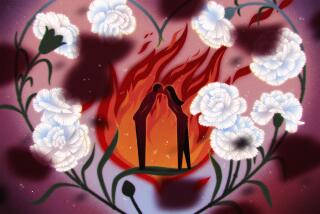What’s Love Got to Do With It?
Legend has it that on his wedding night, the young Victor Hugo made love eight times to his chaste wife, Adele Foucher. As a result of this record-breaking feat by the impassioned author of “Les Miserables,” his bride was left staunchly opposed to this type of activity. (Her winding adulterous adventure with the less-than-attractive Charles Augustin Sainte-Beuve had more to do with spite and revenge than carnal pleasure.)
Scholar Jean Rostand laughed upon hearing this account of Hugo, comparing it to feats in fornication achieved by other animal species. For example, the romantic bard’s eight consecutive effusions pale in comparison to the 40 days and 40 nights during which the male ape copulates with the female without resting for a single moment. However, thanks to a seasoned Frenchwoman, Catherine Millet, amphibians, rabbits and the other great fornicators of the animal kingdom may have met their match in the lowly human species: someone capable of measuring up to them--alas, even defeating them in gross quantity of copulations.
For the record:
12:00 a.m. June 12, 2002 For The Record
Los Angeles Times Wednesday June 12, 2002 Home Edition Main News Part A Page 2 National Desk 25 inches; 898 words Type of Material: Correction
Translator’s name--The review of “The Sexual Life of Catherine M.” that appeared in Sunday’s Book Review should have noted that the review had been translated from Spanish. The review, written by Mario Vargas Llosa, was translated by Roger E. Norum.
For The Record
Los Angeles Times Sunday June 16, 2002 Home Edition Book Review Part R Page 14 Features Desk 1 inches; 44 words Type of Material: Correction
Translator’s name--Last week’s review of “The Sexual Life of Catherine M.” should have noted that the review had been translated from the Spanish. The review, written by Mario Vargas Llosa, was translated by Roger E. Norum.
Who is this Catherine Millet? A distinguished art critic, 53 years old, the Parisian editor of ArtPress and the author of works on such themes as conceptual art, painter Yves Klein, designer Roger Tallon, contemporary art and avant-guard criticism. In 1989 she was the commissioner of the French section of the Sao Paolo Biennial and, in 1995, commissioner of the French Pavilion of the Venice Biennial. Her fame, however, is much more recent. It is the result of a sexual autobiographical book, “The Sexual Life of Catherine M.,” which has caused considerable commotion (Le Monde called it “absolutely staggering”) and topped the bestseller list in France for a number of weeks, selling 350,000 copies. It has been eagerly awaited in America ever since Francine du Plessix Gray praised the French edition nearly a year ago, in the pages of Vogue, as being possessed of a style “as elegant as any French pornography since Sade.” Edmund White called it “the most explicit book about sex ever written by a woman ... that is the opposite of lurid.”
I will say right now that the work of Millet is of much greater merit than one might glean from the ridiculous uproar that has helped to publicize it and also that those who venture to read it solely for the erotic or pornographic halo that adorns it will be disappointed. The book is neither a sexual stimulant nor a processed imagery of erotic ritual but an intelligent reflection, crude, unusually frank, that at moments adopts the clinical prose of a medical report. The author approaches her own sex life with the icy obsessive detail of miniaturists who build ships inside bottles or paint landscapes on the heads of pins. I will also say that this book, while an interesting and valiant work, is not exactly pleasant to read, for the reader is left with a vision of sex that is nearly as exhausting and depressing as that which Madame Hugo suffered following the marital attacks of her wedding night.
Millet began her sex life at 17, rather late for a girl of her generation--that of the great May 1968 social revolution. But she began immediately to make up for lost time, making love right and left, in every possible region of her body, at a truly maddening pace, until reaching numbers that I imagine must have far exceeded the thousands of women whom the compulsive liar Georges Simenon, in his autobiography, boasts of having taken to bed.
I insist on the numbers because she does so herself in the lengthy first part of her book, titled simply, “The Numbers Game,” where she documents her predilection for partouzes, promiscuous sex and group orgies. In the ‘70s and ‘80s, before the sexual liberation movement lost momentum and fell out of fashion all over Europe with the arrival of AIDS, Millet--described as a timid woman, disciplined and rather meek, who in sexual relations found a means of communication with her partners seldom achieved in other aspects of her life--made love in private clubs, in the Bois de Boulogne, on the shoulders of highways, in the vestibules of buildings, on public benches, in private homes and once in the rear of a truck, where she serviced dozens of applicants in just a few hours with the help of her friend Eric, who managed the line outside.
I say “applicants” because I don’t quite know what to call the author’s fleeting and anonymous partners. They aren’t clients, of course, because Millet, although she lavished her favors with a boundless generosity, never charged for them. For her, sex was always enjoyment, sport, routine, pleasure but never profession or business. In spite of the abandon with which she carried on, she claims that she was not once the victim of brutality, nor did she ever feel in danger. Even in potentially aggressive situations, she would simply voice her displeasure so that her sentiments were respected. She had lovers, and now has a husband: a writer and photographer who has just published a book of nudes of his wife.
Yet a lover is someone with whom one assumes a somewhat stable relationship, whereas most of Millet’s sex partners appear as silhouettes in passing, seized and carelessly abandoned, almost without the slightest conversation between the two. Individuals without name, without face, without history, the men who parade through this book are, much like the furtive vulvas of libertine novels, little more than transitory penises. Until now, in autobiographical literature, it was only libertine men who made love in this fashion, blindly and in bulk, caring little about their partners. This book shows us that we are highly mistaken in adhering to the notion that chain sex, that is, sex strictly as carnal gymnasium, void of any sentiment or emotion, is the exclusive right of men. This may in fact be the most scandalous conceit in the book.
I should mention that Millet does not in these pages make the slightest display of being a feminist. She does not proclaim her rich experience in sexual material as a victory flag, nor is it an accusation against the sexual prejudice and discrimination which women still suffer today. Her testament is void both of harangue and of the slightest pretension to illustrate any general, ethical, political or social truth. On the contrary, her individualism is extreme and quite visible in its penchant for not making valid conclusions for everyone based on her own personal experience, undoubtedly because she does not believe these conclusions exist. Why has she made public, then, via a sexual self-autopsy without precedent, that very intimacy males and females hide under lock and key? It would appear that it is to see if we can better understand it this way, if it offers enough perspective to change that dark well of first moves, ecstasies, courages, excesses and confusion into knowledge into clear and coherent ideas. For despite the air of liberty she has ascribed to it, for Millet, it is all still sex.
The most disconcerting thing about this memoir is the coldness with which it is written. The prose is efficient, lucid and often abstract. But this coldness doesn’t merely pervade expression and reason. It is also the material, the sex itself, which breathes a cool air and, in many places, depresses. Millet assures us that many of her associates satisfy her, they help her to materialize her phantoms, that she enjoys herself with them. But do they really fulfill her, do they really give her pleasure? The truth is that her orgasms frequently seem mechanical, resigned and even sad. She herself implies this in a fairly unequivocal manner, in the final pages of her book, in which she points out that despite the diversity of people she has had sex with, she’s never felt as sexually fulfilled as while (“with the punctuality of a functionary”) masturbating. So the extended macho (now, the very fact that this exists as an adjective is called into discussion) belief that in sex, pleasure is found only in variation, is not always true. As Millet might say, none of her countless partners of flesh and bone was able to dethrone her own spined phantom.
This book confirms what all of sexual literature has shown ad nauseum: that sex, separate from the other activities and functions that constitute our existence, is extremely monotone, so limited in horizon that it ends up dehumanizing. A life polarized by sex alone reduces the function to a basic organic activity, no more noble or pleasurable than swallowing or defecating. Only when civilized by culture, burdened with emotion and passion and clothed with ceremony and ritual does sex really enrich human life, and only then do its positive aspects mediate the ups and downs of everyday existence. As George Bataille explained, for this sublimation to occur, it is essential that we preserve certain taboos and rules which both enliven and retard sex, such that physical love can be experienced--enjoyed--as a transgression. Unrestrained liberty and the renunciation of all theatricality and formalism in its practice, which has been presented as a conquest in certain enclaves of the Western world, have not contributed to enriching the pleasure and happiness of human beings thanks to sex. It has instead made it boring and blind, converting physical love into mere gymnastics and routine.This is one of the most fertile and mysterious sources of the human phenomenon.
Apart from this, it helps not to forget that the sexual liberty displayed with such eloquence in the work of Millet is still the privilege of few. At the same time I was reading her book, I read in the Parisian press of the stoning of an Iranian woman whom a tribunal of fanatic imams had found guilty of appearing in pornographic films. We should clarify that “pornography” in a fundamentalist Islamic theocracy consists of a woman showing her hair. The woman, in accordance with Koranic law, was buried alive in a public square up to her breasts and stoned to death.
More to Read
Sign up for our Book Club newsletter
Get the latest news, events and more from the Los Angeles Times Book Club, and help us get L.A. reading and talking.
You may occasionally receive promotional content from the Los Angeles Times.







